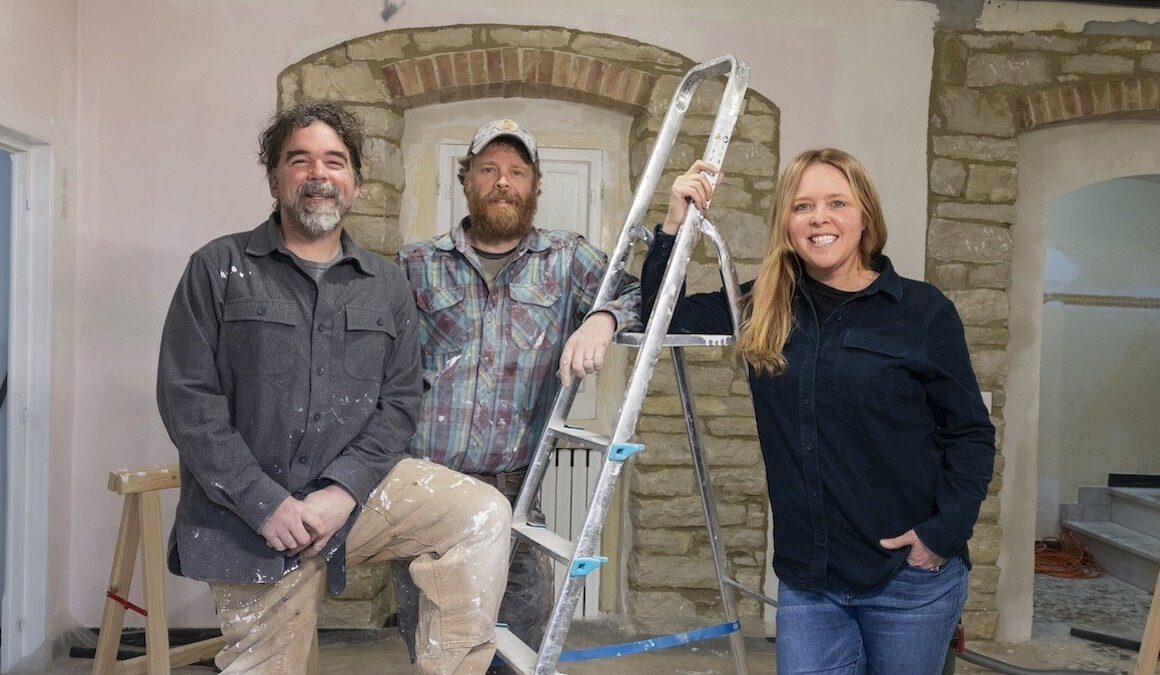The stars of “Maine Cabin Masters” traded the forests of the U.S. Northeast for the foothills of Italy to renovate a family vacation home on “Main Cabin Masters: Building Italy.” And work there continues this summer, says builder Chase Morrill.
On the Magnolia Network show, which aired its finale this month, the builder purchases a 100- to 200-year-old property listed for $97,000 in Italy’s remote Abruzzo and Molise region. He brings out sister Ashley Morrill and brother-in-law Ryan Eldridge to help transform the place. They have just three months to finish it all, since they can only work on the project abroad during time off from filming their regular “Maine Cabin Masters” series in the States.
Curious to learn how they made such a tight timeline and budget work, we got the trio to share why they took this construction challenge on in the first place, and what they learned about buying and building in a foreign country.
Plus, they reveal which corners they were comfortable cutting to get the job done for the TV show, and which upgrades they’ve done since filming has wrapped.

(Magnolia Network)

(Magnolia Network)

(Magnolia Network)
How did you meet the tight timeline and budget you were working with?
Chase Morrill: Luckily, we had the experience of working on tight timelines and budgets with “Maine Cabin Masters.”
There were tricks to making it work and to being able to get it done and ready for TV. We knew where we could say, “Windows always take long to order so get those ordered right away.” And then paint everything white.
Down the road, we can paint rooms different colors if we want to, but at least everything gets a fresh coat of paint. What windows could we leave? What didn’t need to be touched? I think that was a big thing, too.
Same thing with cabinets. We knew we couldn’t do custom cabinets because it would take too long, so we went with an Ikea cabinet that typically they have in stock regularly. That type of stuff that helps us get the project done on time.

(Magnolia Network)

(Magnolia Networks)
Are there any more upgrades you want to make to the place?
Chase: My wife has been over there making it our own, just kind of rearranging a few things. We added a washing machine to the upstairs bathroom.
There’s a wooden patio area we put on the exterior that, it’s not a long-term solution but at least it got done and it’s somewhere we can sit and hang out. Ideally, it would be a stone patio, but that takes longer and bigger budgets.
We replaced a lot of the downstairs basement windows because they didn’t have windows, but over time, we’ll eventually replace more windows as we go.
Ashley Morrill: There is an old stable that would make an excellent guesthouse. There’s a couple other outbuildings on the property, and there’s also a summer kitchen, which is really cool that we didn’t get to touch. It’s a separate little building built into the side of the hill. Really cute with an old brick oven.

(Magnolia Network)
How often have you been back since wrapping up work?
Chase: I was there for the week of Fourth of July. I went over with my youngest daughter, her friend, and my wife. Sarah [Morrill] stayed over there for three weeks, [and] my oldest and some of her friends went over while Sarah was there.
When we finished up, we had two nights to stay in the house before we had to leave. We got it done, but we didn’t have hot water, so it’s nice to go back, get the water going, get a washing machine, get the dishwasher connected—stuff like that that really makes it our own.
I think we are heading back in October, and we’ve got a long list of people already signing up to use the place.
Ashley: We have not been back. We most definitely will.
Ryan Eldridge: We are already missing it. Watching the episodes made us miss living there [and] the people we met, so we will be back, I promise you that.
What first inspired you to do the project in Italy?
Chase: My wife and I always talked about when we retired, buying an old abandoned place and fixing it up.
I was talking to a producer about “Someday I would love to buy a house and fix it up,” and he’s like, “Do you mind if I pitch this idea to the network?”
He pitched it, and it ended up happening much sooner than expected, but it was a blessing because we were able to do it as a family. My oldest just graduated high school—she’s off to college—so we were able to do it as one big family together, which made it all the more special.
Italy was offering those one-euro homes—and, of course, anywhere there’s a bargain, I’m checking it out. We looked at a few of those properties. There were a lot of stipulations, a lot of requirements. It was more like a foreclosure, buyer beware. But that got the ball rolling.
We were pretty specific in what we were looking for because we had to fit all of us as a family and we had to be able to get the work done in three months. It couldn’t be too run down, but it couldn’t be too nice. We looked at over a couple hundred properties online. Then we went over there as a family and scouted a bunch of properties. We were extremely lucky to actually find a property that met all our requirements. Once we saw it, and once my wife walked out on that balcony and saw the views, I knew it was over. That was the property.
Eldridge: And we all love Italian food and wine!

(Magnolia Network)

(Magnolia Network)
Did you happen to watch fellow TV renovators Dave and Jenny Marrs on ‘Fixer to Fabulous: Italiano’?
Ashley: I haven’t been able to watch it yet. It came out when we were in Italy working, so we didn’t have access to that TV, but it’s definitely on my radar.
What lessons did you learn about house hunting abroad?
Chase: Definitely work with a Realtor®. Definitely work with a Realtor who speaks English and Italian. And have a real estate lawyer, whether they’re in the U.S. or Italy, just somebody who can do all the legwork for you because it’s tough.
We fortunately had the network and the production team working with us to help make it happen. But there’s so much paperwork, there’s so much research that has to be done, and it’s a long process.
Our property had 13 individual owners and 23 different parcels—and that’s super common apparently. Without the real estate agent, the notary, and the lawyer working with us to help figure it out, it never would have happened in the time frame and would have just been so much more difficult.
What made this property stand out from the others?
Eldridge: It’s nestled in this little hillside, and it’s up in the top of this little valley. It’s just a beautiful spot.
I think everyone could see the potential when we first saw it. The roof was straight, and you didn’t see anything crumbling. You could tell it had good bones, but the view was just unbelievable.
Ashley: And it had the stones and tiles that you would picture in a traditional Italian home.

(Magnolia Network)

(Magnolia Network)
What are the unique challenges of building abroad?
Chase: With buying the house [and] the permitting process, it’s a whole long, drawn-out process. Italian law requires you to have an Italian contractor take the lead on the project.
Where we were, [there’s] seismic activity, so you had to have an engineer assess the building, make sure anything we were doing wasn’t structural, and stuff like that.
It’s a long process, and even the Italians were just amazed that we were able to get the work done, that we did in such a short amount of time because it’s just not common over there.
What helped you navigate such a tricky renovation process?
Eldridge: We were lucky because the production company provided us with translators; they did make it easier. We went in with Google Translate and a smile on our face, and we did find some amazing local help, too.
Chase: Patience is a big one, and just sticking with it and trusting the process. Italy’s been around for so long. They know what they’re doing. They build buildings that last for thousands and thousands of years, so it’s having the patience and the respect to trust the process and let the building dictate the build.
Go into a place and say, “What am I looking to do, and what’s the best way to work with the building?” The building’s almost the boss. What’s the easiest and what’s the most economical? What’s the path of least resistance to get what you want within the confines of the structure?

(Magnolia Network)

(Magnolia Network)
Did Italian materials and building techniques differ much from what you’re used to in Maine?
Chase: You go in a lumber yard out here, and you have hundreds of choices of materials for wood products. You go to a lumber yard over there, you maybe have four choices of lumber, but you have hundreds of choices of cement, masonry, [and] stucco products, and each one has a different application, a different usage.
It’s just a whole different style for us than what we’re used to for Maine. It was interesting, too, when we were working with wood, the contractors over there were impressed by how we were able to do what we do with wood so well and quickly.
Eldridge: I’ve done a lot of tile, and I learned they will tile right over plasterboard, which is Sheetrock. They don’t put the Hardie Backer down. They also back-butter every tile before they put it up, they just don’t do a mud set.
I was amazed at the exterior. The contractors were just so quick. They had these products, and the way they did it was so much more economical and fast than the way we would do it.
We thought we were going to have to chip off all the old plaster and stone. They put this mesh over it and worked from the top down. They skim-coated that house in this beautiful color, this cool stucco [that was] pre-colored. It’s a product I’d never seen before. They transformed the outside in much less time than if we were to.

(Magnolia Network)
How do you describe the interior design and decor?
Ashley: It’s very eclectic and environmentally friendly. If there’s a piece of furniture you can repurpose and reuse, then [Chase and Sarah] would much rather save that and fix it up rather than put it in a landfill. If they find a tile that is on sale and it’s beautiful, they’re going to go with something like that or something local from the area. They’re always trying to consider their surroundings and also the environment.

(Magnolia Network)

(Magnolia Network)
What’s your favorite memory from this experience?
Ashley: All of us being down there chipping away the old plaster. We were all down there for days just chipping away. We would have dance parties! We made the most of it.
Eldridge: We had a lot of fun. We would play music and be silly. The kids worked so hard, and it was amazing to see how much they’ve learned from their family.
Chase: Being able to do it as a family was a once-in-a-lifetime opportunity. At one point we were building the deck, and my mother, my aunt, and my aunt and uncle—they all came over for a visit. We were all working on the deck, so it really was all hands on deck [of] family all working together.
And then sitting down in the Italian countryside having a glass of wine looking out after a hard [day’s] work, it just didn’t get any better than that.

(Magnolia Network)

(Magnolia Network)
The full season of “Maine Cabin Masters: Building Italy” will be available to stream on Aug. 30 on Max and discovery+.







